Changes in Tropical-Cyclone Translation Speed over the Western North Pacific
Abstract
1. Introduction
2. Data and Methods
3. Results
4. Discussion
Author Contributions
Funding
Acknowledgments
Conflicts of Interest
References
- Lee, T.C. A review on the long-term variations of tropical cyclone activity in the typhoon committee region. Trop. Cyclone Res. Rev. 2012, 1, 41–45. [Google Scholar]
- Hu, C.; Zhang, C.; Yang, S.; Chen, D.; He, S. Perspective on the northwestward shift of autumn tropical cyclogenesis locations over the western North Pacific from shifting ENSO. Clim. Dyn. 2018, 51, 2455–2465. [Google Scholar] [CrossRef]
- Hu, C.; Zhang, C.; Yang, S.; Chen, D. Variable correspondence between western North Pacific tropical cyclone frequency and east Asian subtropical jet stream during boreal summer: A tropical Pacific SST perspective. Int. J. Climatol. 2019, 39, 1768–1776. [Google Scholar] [CrossRef]
- Xu, S.; Wang, B. Enhanced western North Pacific tropical cyclone activity in May in recent years. Clim. Dyn. 2014, 42, 383. [Google Scholar] [CrossRef]
- Kossin, J.P.; Emanuel, K.A.; Vecchi, G.A. The poleward migration of the location of tropical cyclone maximum intensity. Nature 2014, 509, 349–352. [Google Scholar] [CrossRef]
- Song, J.; Klotzbach, P.J. What has controlled the poleward migration of annual averaged location of tropical cyclone lifetime maximum intensity over the Western North Pacific since 1961? Geophys. Res. Lett. 2018, 45. [Google Scholar] [CrossRef]
- Zhang, H.; Guan, Y. Latitudinal distribution of landing tropical cyclones over mainland China. Acta Phys. Sin. 2012, 61, 169203. (In Chinese) [Google Scholar]
- Zhang, H.; Guan, Y. Relationship between the South China Sea summer monsoon and the first-landfall tropical cyclone over mainland of China. Acta Phys. Sin. 2012, 61, 129201. (In Chinese) [Google Scholar]
- Zhang, H.; Guan, Y. Impacts of four types of ENSO events on tropical cyclones making landfall over mainland china based on three best-track datasets. Adv. Atmos. Sci. 2014, 31, 154–164. [Google Scholar] [CrossRef]
- Kossin, J.P. A global slowdown of tropical-cyclone translation speed. Nature 2018, 558, 104–107. [Google Scholar] [CrossRef]
- Moon, I.-J.; Kim, S.-H.; Chan, J.C.L. Climate change and tropical cyclone trend. Nature 2019. [Google Scholar] [CrossRef] [PubMed]
- Kossin, J.P. Reply to: Moon, I.-J. et al.; Lanzante, L.R. Nature 2019, 570, E16–E22. [Google Scholar] [CrossRef] [PubMed]
- Lanzante, J.R. Uncertainties in tropical-cyclone translation speed. Nature 2019. [Google Scholar] [CrossRef] [PubMed]
- Chan, K.T.F. Are global tropical cyclones moving slower in a warming climate? Environ. Res. Lett. 2019, 14, 104015. [Google Scholar] [CrossRef]
- Guan, S.; Li, S.; Hou, Y.; Hu, P.; Liu, Z.; Feng, J. Increasing threat of landfalling typhoons in the western North Pacific between 1974 and 2013. Int. J. Appl. Earth Obs. Geoinf. 2018, 68, 279–286. [Google Scholar] [CrossRef]
- Webster, P.J.; Holland, G.J.; Curry, J.A.; Chang, H.R. Changes in tropical cyclone number, duration, and intensity in a warming environment. Science 2005, 309, 1844–1846. [Google Scholar] [CrossRef]
- Emanuel, L.K.A. Increasing destructiveness of tropical cyclones over the past 30 years. Nature 2005, 436, 686–688. [Google Scholar] [CrossRef]
- Klotzbac, H.P.J. Trends in global tropical cyclone activity over the past twenty years (1986–2005). Geophys. Res. 2006, 33. [Google Scholar] [CrossRef]
- Chan, J.C.L. Comment on “Changes in Tropical Cyclone Number, Duration, and Intensity in a Warming Environment”. Science 2006, 311, 1713. [Google Scholar] [CrossRef]
- Kamahori, H.; Yamazaki, N.; Mannoji, N.; Takahashi, K. Variability in intense tropical cyclone days in the western North Pacific. SOLA 2006, 2, 104–107. [Google Scholar] [CrossRef]
- Landsea, A.C.W.; Harper, B.A.; Hoarau, K.; Knaff, J.A. Can we detect trends in extreme tropical cyclones? Science 2006, 313, 452–454. [Google Scholar] [CrossRef] [PubMed]
- Ying, M.; Zhang, W.; Yu, H.; Lu, X.; Feng, J.; Fan, Y.; Zhu, Y.; Chen, D. An overview of the China Meteorological Administration tropical cyclone database. J. Atmos. Ocean. Technol. 2014, 31, 287–301. [Google Scholar] [CrossRef]
- Chu, J.-H.; Sampson, C.R.; Levine, A.S.; Fukada, E. The Joint Typhoon Warning Center Tropical Cyclone Best-Tracks, 1945–2000; Naval Research Laboratory: Washington, DC, USA, 2002. [Google Scholar]
- Liang, J.; Ren, F.M.; Yang, X.Q. Study on the differences between CMA and JTWC tropical cyclone datasets for northwest Pacific. Acta Oceanol. Sin. 2010, 32, 10–22. (In Chinese) [Google Scholar]
- Ren, F.M.; Liang, J.; Wu, G.X.; Dong, W.J.; Yang, X.Q. Reliability analysis of climate change of tropical cyclone activity over the western North Pacific. J. Clim. 2011, 24, 5887–5898. [Google Scholar] [CrossRef]
- Kalnay, E.; Kanamitsu, M.; Kistler, R.; Collins, W.; Deaven, D.; Gandin, L.; Iredell, M.; Saha, S.; White, G.; Woollen, J.; et al. The NCEP/NCAR 40-year reanalysis project. Bull. Am. Meteorol. Soc. 1996, 77, 437–470. [Google Scholar] [CrossRef]
- Schreck, C.J.; Knapp, K.R.; Kossin, J.P. The impact of best track discrepancies on global tropical cyclone climatologies. Mon. Weather Rev. 2014, 142, 3881–3899. [Google Scholar] [CrossRef]
- Chan, J.C.L.; Gray, W.M. Tropical cyclone movement and surrounding flow relationship. Mon. Weather Rev. 1982, 110, 1354–1374. [Google Scholar] [CrossRef]
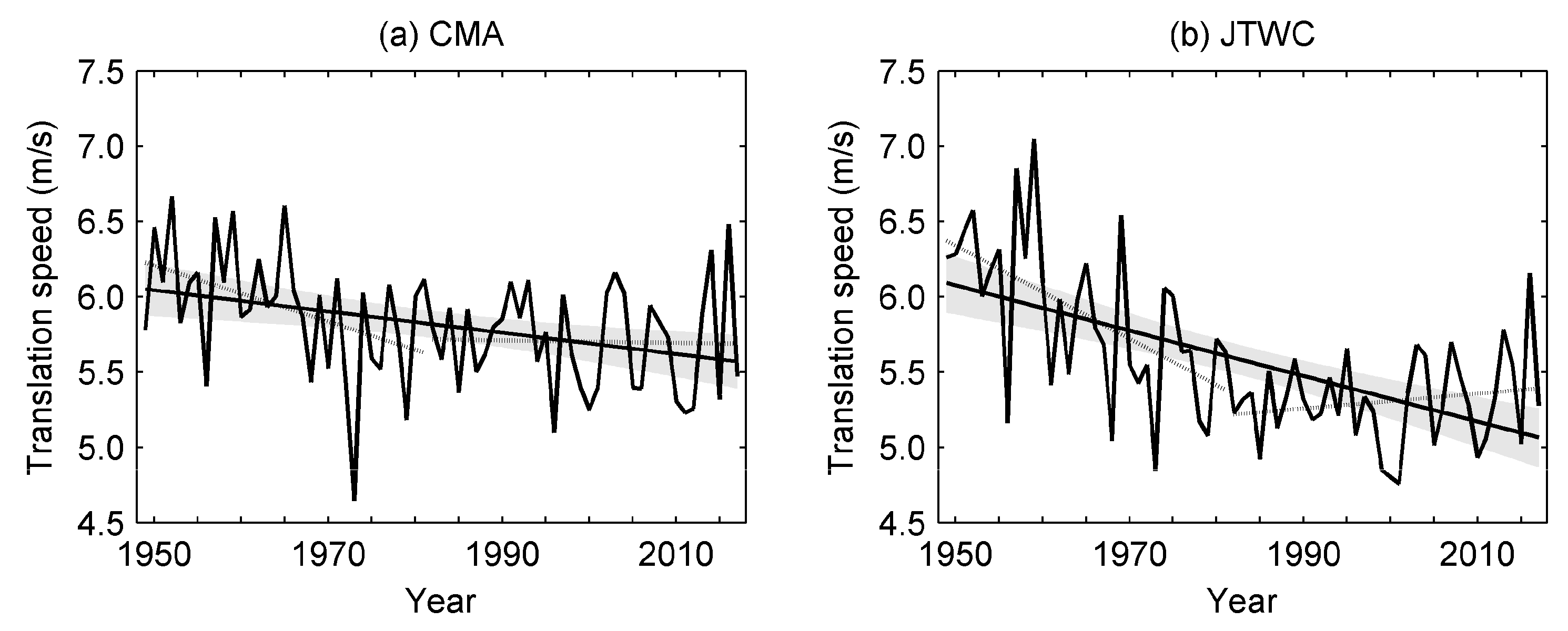
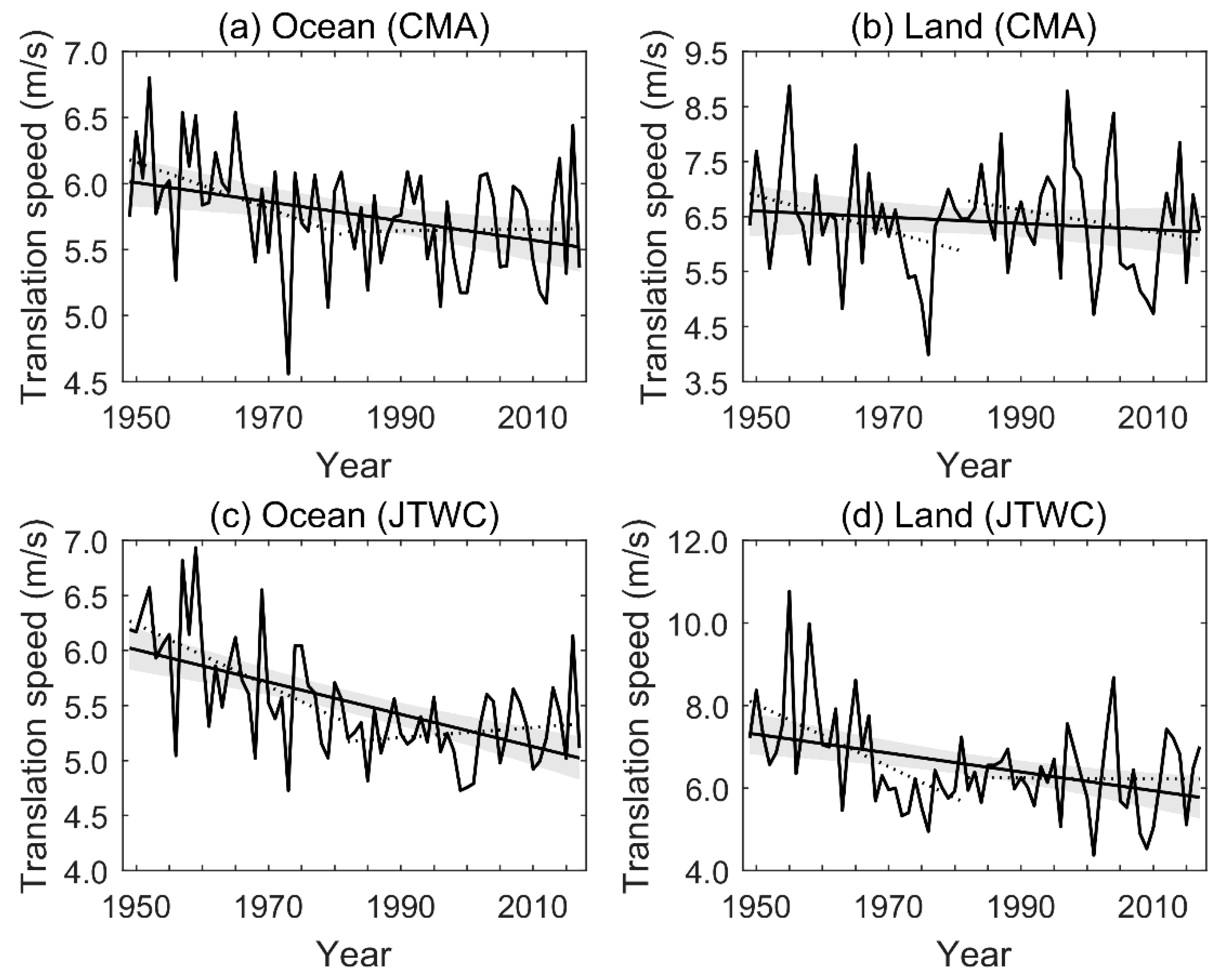
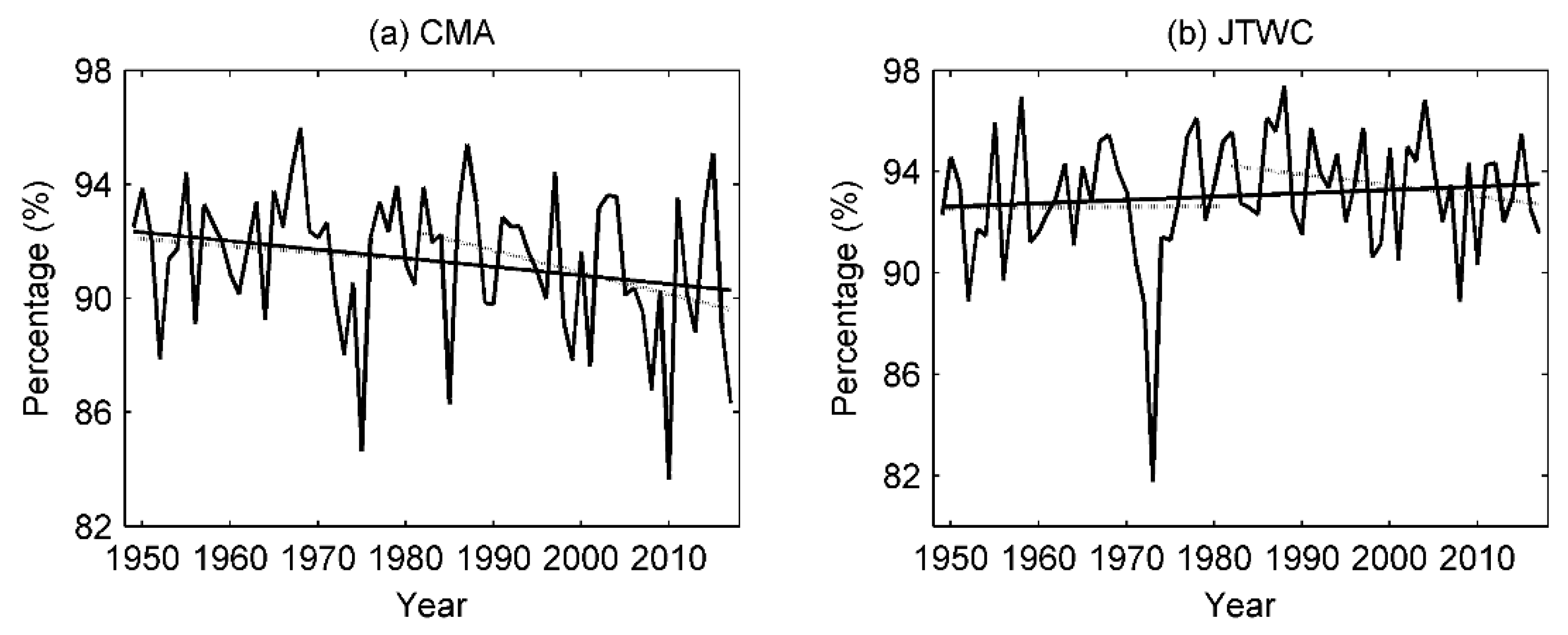
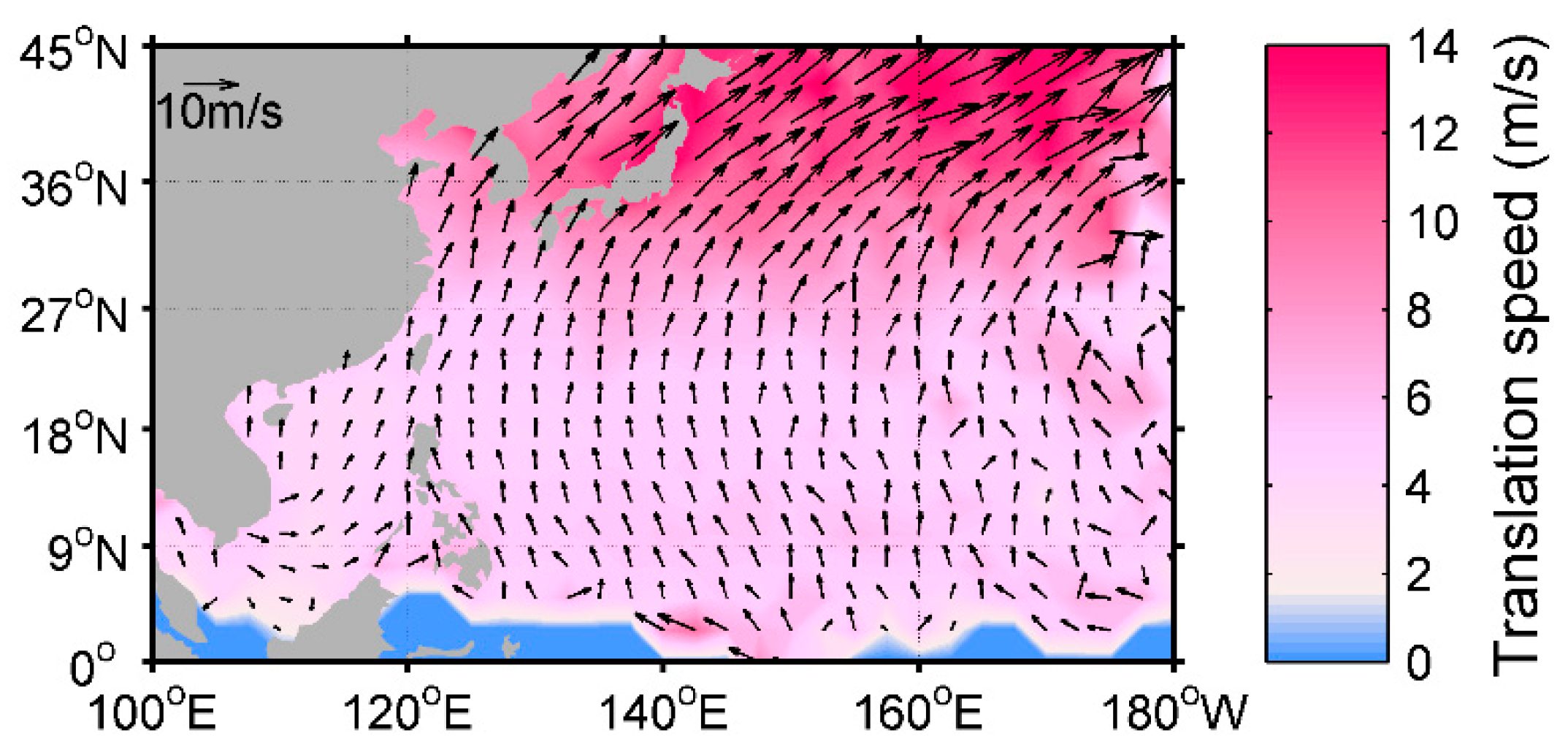

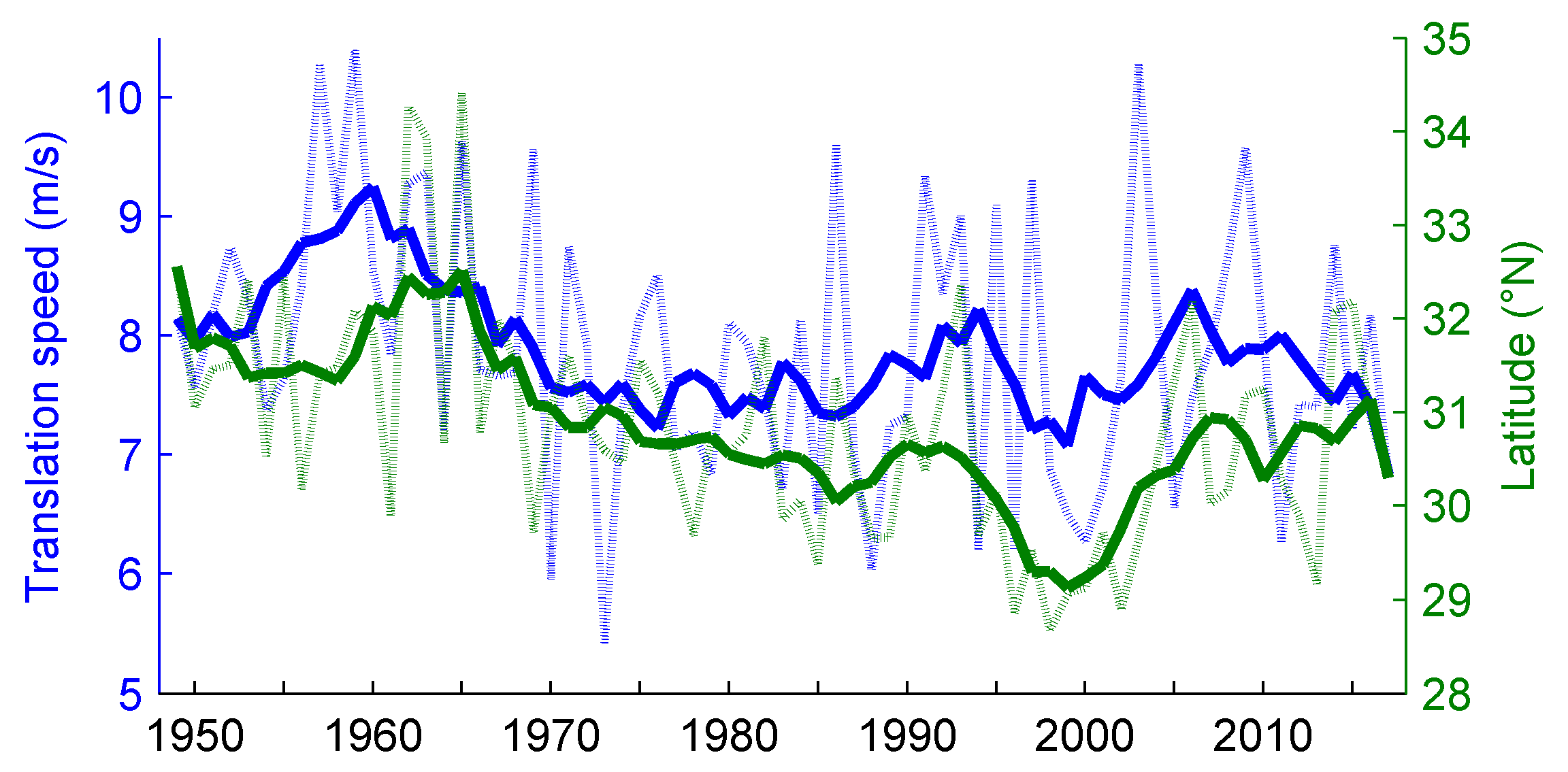
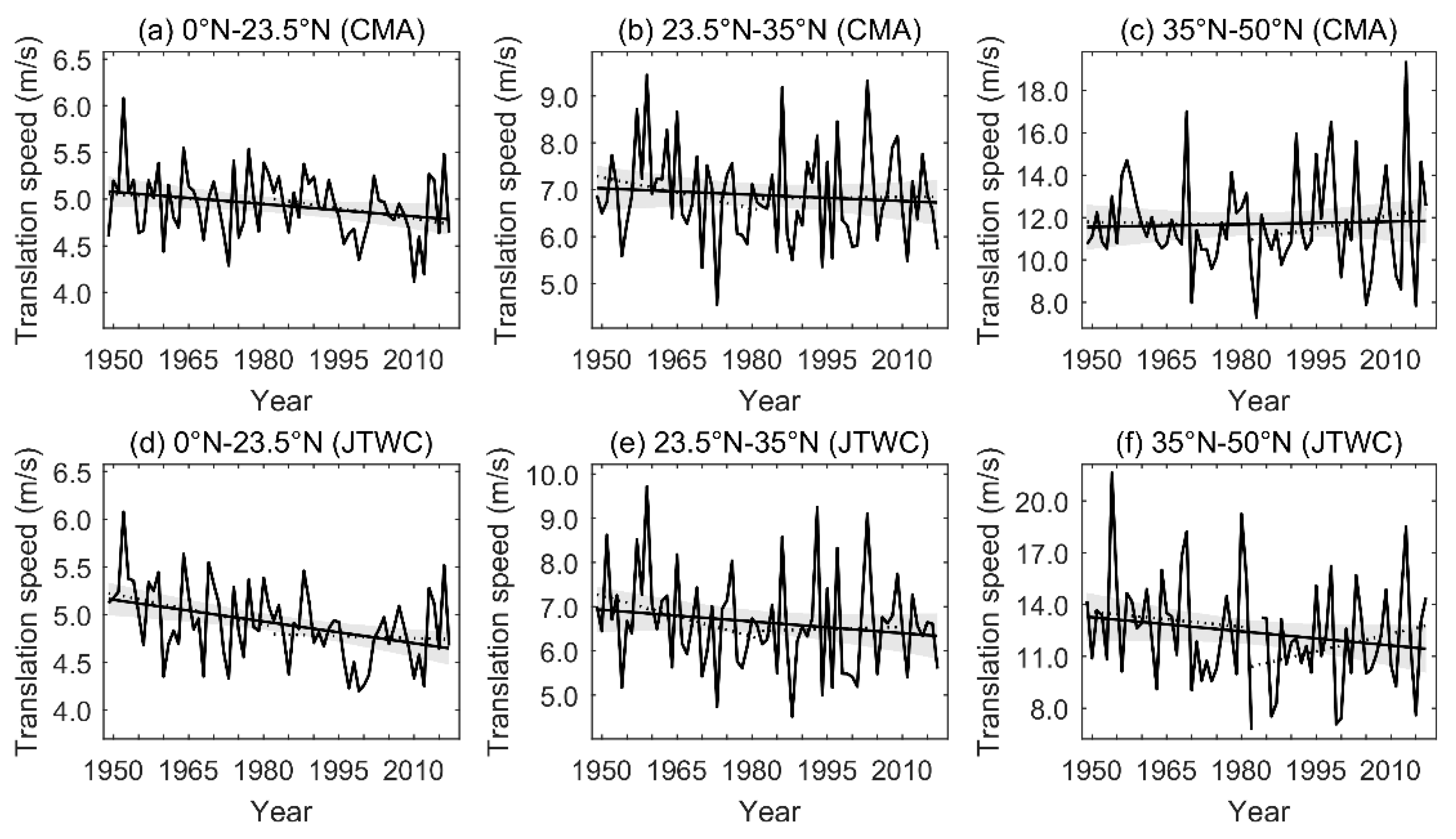
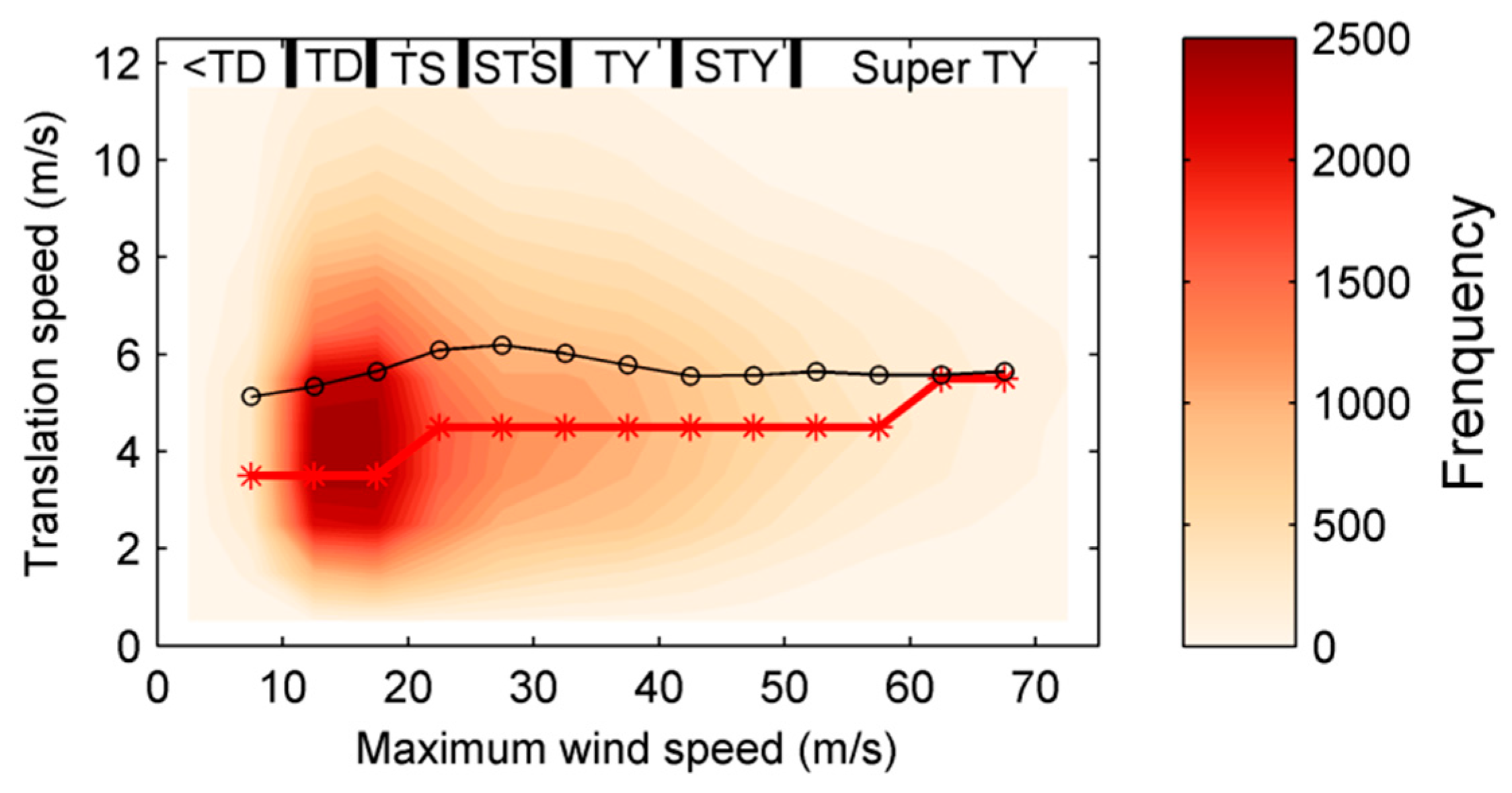
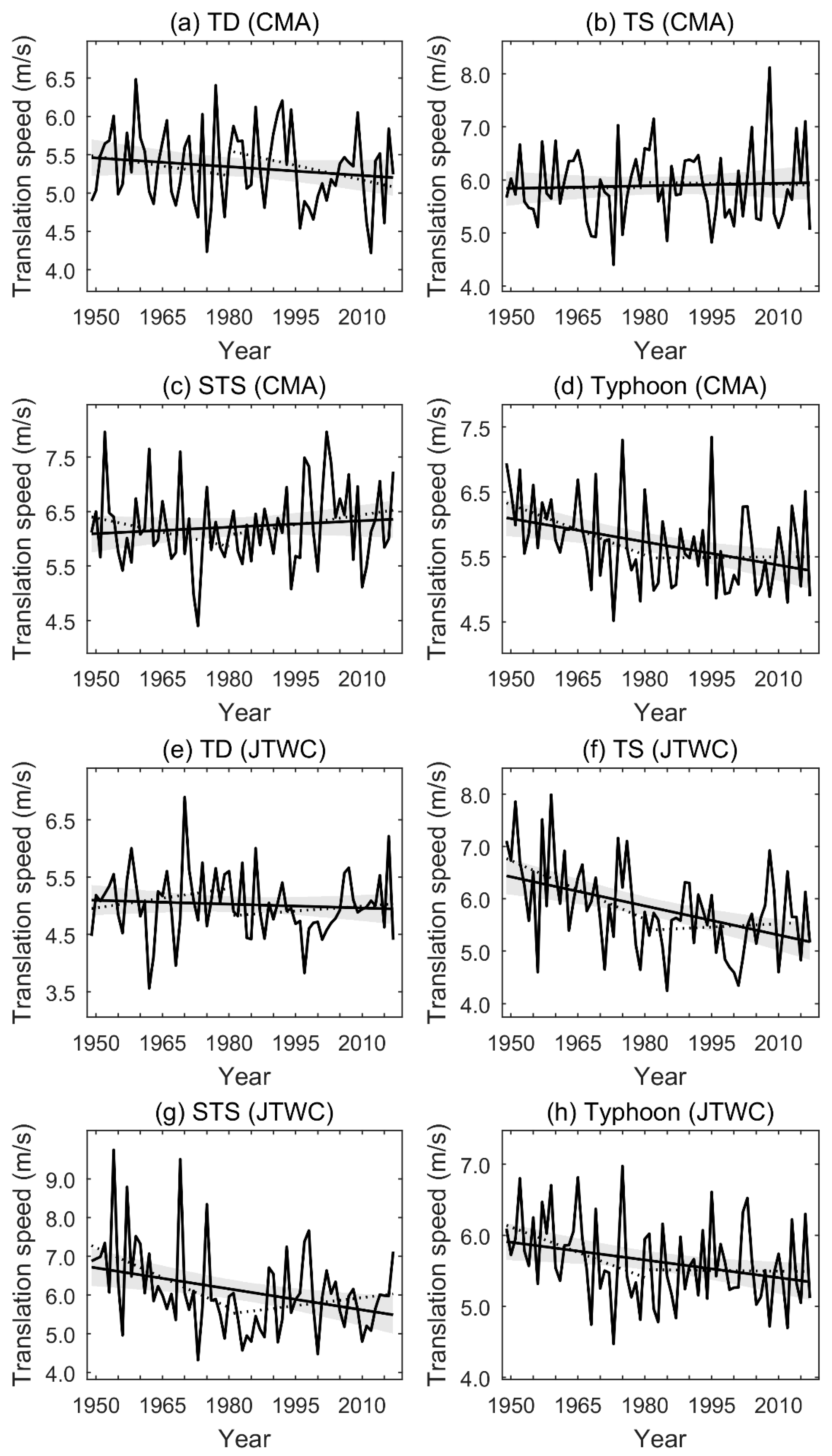


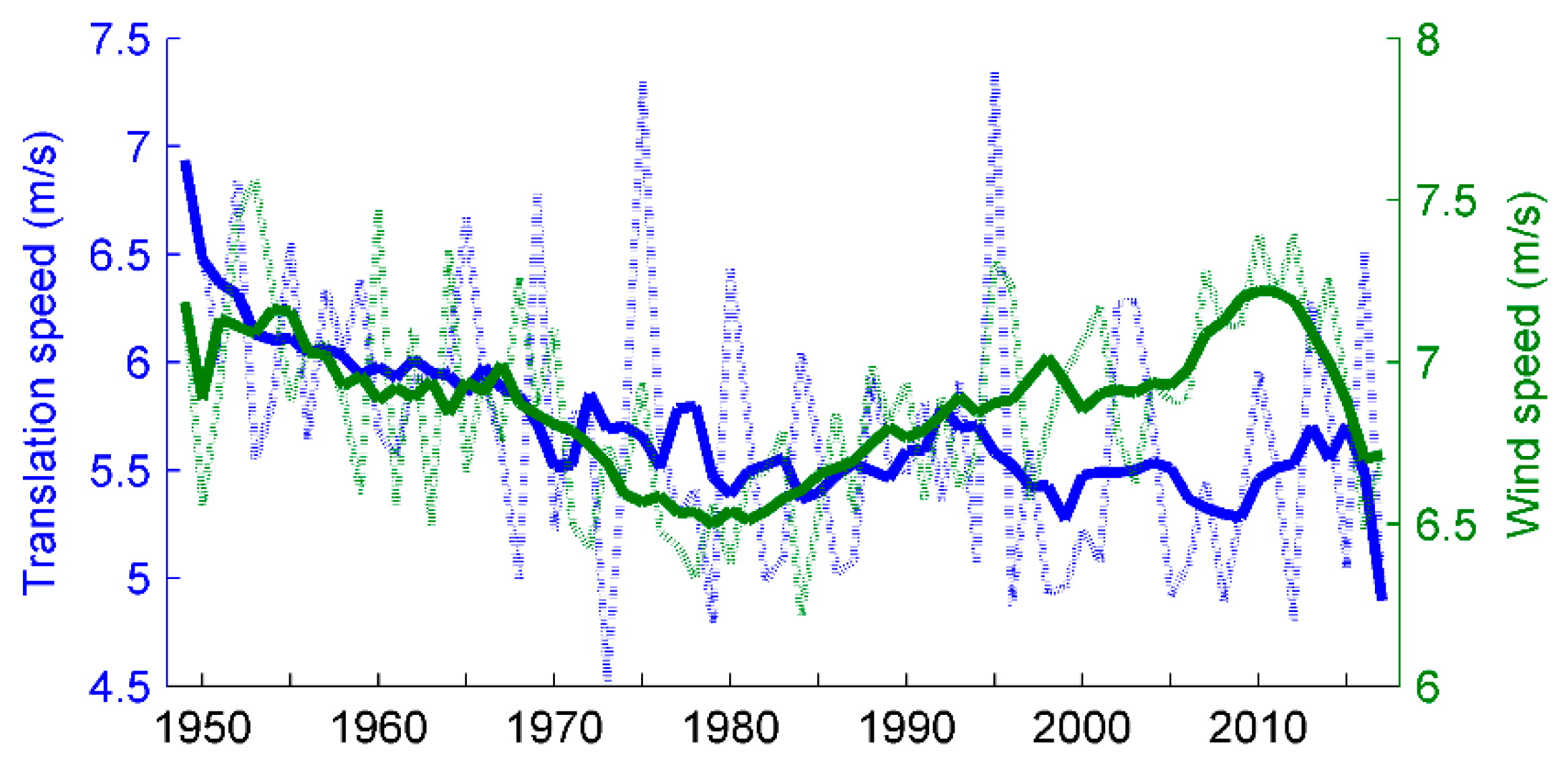
| 1949–1981 Trend (p-Value) | 1982–2017 Trend (p-Value) | 1949–2017 Trend (p-Value) | |
|---|---|---|---|
| CMA | −0.019 (0.01) | −0.001 (0.88) | −0.007 (0.00) |
| JTWC | −0.031 (0.00) | 0.005 (0.31) | −0.015 (0.00) |
| ocean (CMA) | −0.018 (0.03) | 0.001 (0.91) | −0.007 (0.00) |
| ocean (JTWC) | −0.028 (0.00) | 0.005 (0.34) | −0.015 (0.00) |
| land (CMA) | −0.033 (0.06) | −0.020 (0.22) | −0.006 (0.34) |
| land (JTWC) | −0.076 (0.00) | −0.001 (0.94) | −0.023 (0.00) |
| 0–23.5° N (CMA) | −0.003 (0.65) | −0.008 (0.14) | −0.004 (0.04) |
| 0–23.5° N (JTWC) | −0.011 (0.14) | −0.002 (0.78) | −0.008 (0.00) |
| 23.5–35° N (CMA) | −0.022 (0.22) | 0.001 (0.95) | −0.005 (0.46) |
| 23.5–35° N (JTWC) | −0.031 (0.11) | 0.003 (0.87) | −0.009 (0.18) |
| 35–50° N (CMA) | −0.005 (0.88) | 0.041 (0.34) | 0.004 (0.75) |
| 35–50° N (JTWC) | −0.029 (0.60) | 0.068 (0.15) | −0.027 (0.13) |
| tropical depression (CMA) | −0.009 (0.41) | −0.013 (0.09) | −0.004 (0.21) |
| tropical depression (JTWC) | 0.011 (0.35) | 0.006 (0.45) | −0002 (0.51) |
| tropical storm (CMA) | 0.000 (0.98) | −0.001 (0.91) | 0.002 (0.70) |
| tropical storm (JTWC) | −0.037 (0.02) | 0.004 (0.67) | −0.019 (0.00) |
| severe tropical storm (CMA) | −0.018 (0.21) | 0.012 (0.27) | 0.004 (0.37) |
| severe tropical storm (JTWC) | −0.052 (0.03) | 0.014 (0.26) | −0.019 (0.00) |
| >=typhoon (CMA) | −0.026 (0.03) | 0.001 (0.95) | −0.012 (0.00) |
| >=typhoon (JTWC) | −0.024 (0.04) | −0.001 (0.93) | −0.008 (0.01) |
| Maximum Wind Speed | TC Intensity |
|---|---|
| 10.8–17.1 m/s | Tropical depression (TD) |
| 17.2–24.4 m/s | Tropical storm (TS) |
| 24.5–32.6 m/s | Severe tropical storm (STS) |
| 32.7–41.4 m/s | Typhoon (TY) |
| 41.5–50.9 m/s | Severe typhoon (STY) |
| ≥51.0 m/s | Super typhoon (Super TY) |
© 2020 by the authors. Licensee MDPI, Basel, Switzerland. This article is an open access article distributed under the terms and conditions of the Creative Commons Attribution (CC BY) license (http://creativecommons.org/licenses/by/4.0/).
Share and Cite
Zhang, D.; Zhang, H.; Zheng, J.; Cheng, X.; Tian, D.; Chen, D. Changes in Tropical-Cyclone Translation Speed over the Western North Pacific. Atmosphere 2020, 11, 93. https://doi.org/10.3390/atmos11010093
Zhang D, Zhang H, Zheng J, Cheng X, Tian D, Chen D. Changes in Tropical-Cyclone Translation Speed over the Western North Pacific. Atmosphere. 2020; 11(1):93. https://doi.org/10.3390/atmos11010093
Chicago/Turabian StyleZhang, Dongna, Han Zhang, Jiayu Zheng, Xuhua Cheng, Di Tian, and Dake Chen. 2020. "Changes in Tropical-Cyclone Translation Speed over the Western North Pacific" Atmosphere 11, no. 1: 93. https://doi.org/10.3390/atmos11010093
APA StyleZhang, D., Zhang, H., Zheng, J., Cheng, X., Tian, D., & Chen, D. (2020). Changes in Tropical-Cyclone Translation Speed over the Western North Pacific. Atmosphere, 11(1), 93. https://doi.org/10.3390/atmos11010093






